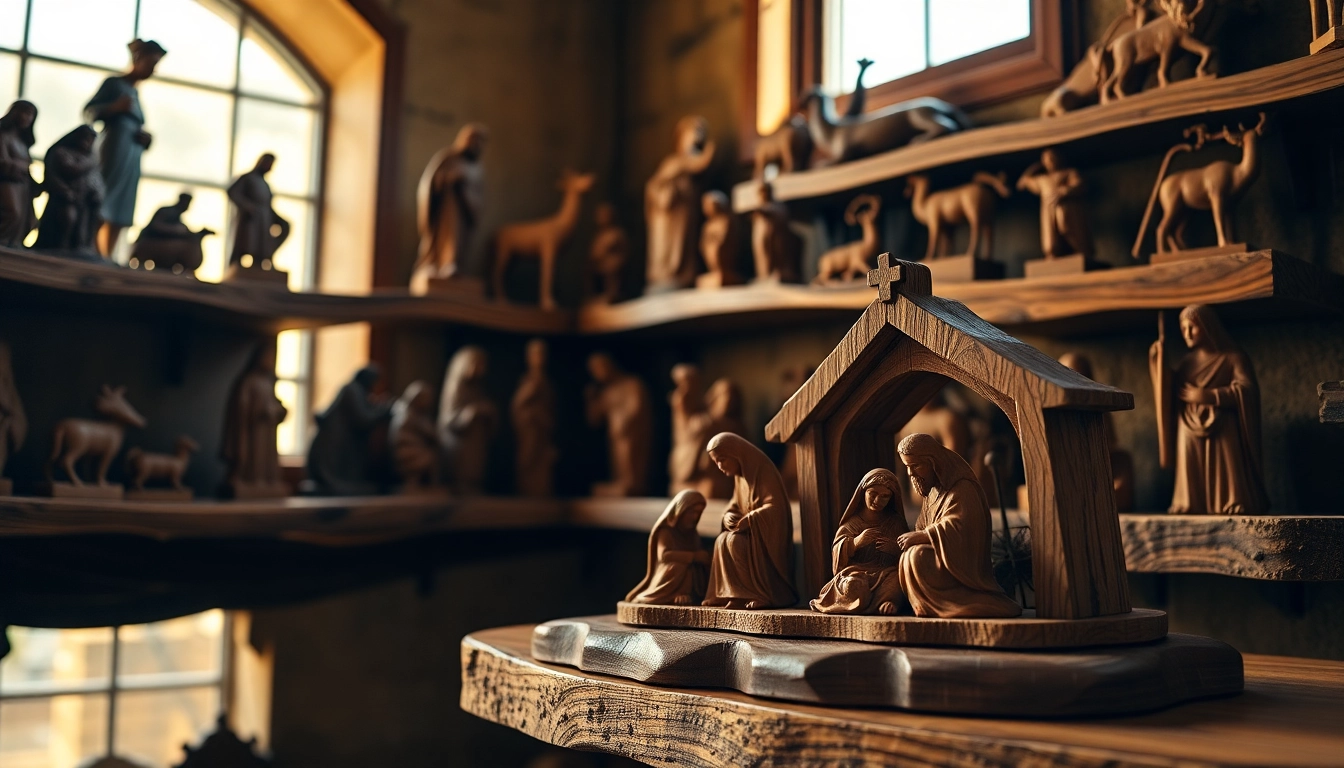The Art of Olive Wood Carvings
Olive wood carvings are more than mere decorative art; they embody a rich cultural heritage that has been passed down through generations. Artisans in the Holy Land, particularly in Bethlehem and Jerusalem, transform the sacred wood from ancient olive trees into intricate sculptures and functional objects, each telling its own unique story. These olive wood carvings have grown in popularity worldwide, admired for their aesthetic beauty and profound spiritual significance.
1.1 Historical Significance of Olive Wood in Art
The history of olive wood carving in the Holy Land dates back to Biblical times. This sturdy wood, extracted from sacred trees that symbolize peace and prosperity, has been revered not only for its durability but also for its association with numerous religious and cultural narratives. Olive trees can live for thousands of years, making their wood a lasting testament to history. For many artisans, carving olive wood is not just a craft but a way to connect with their heritage, preserving traditions that have survived through centuries of change and conflict.
1.2 Techniques Used by Artisans
Carving olive wood is a meticulous process that requires skill and patience. Artisans typically start by selecting high-quality wood from pruned olive trees, ensuring that each piece possesses a unique grain and color. The intricate designs range from religious figures and nativity scenes to functional objects like bowls and crosses. Techniques passed down from generation to generation, such as whittling, chiseling, and sanding, create the final products that are not only beautiful but also tell the story of the skilled hands that shaped them.
1.3 The Symbolism Behind Olive Wood Sculptures
Each olive wood carving symbolizes various spiritual meanings and cultural ties. The olive tree is a symbol of peace in many cultures, and sculptors use its wood to create pieces that reflect hope, faith, and endurance. Figures representing Biblical stories or saints are common, serving as reminders of faith for both creators and owners. The artistry involved connects people to their religious beliefs and cultural identities, allowing them to share a piece of their heritage with the world.
Discovering Unique Olive Wood Carvings
2.1 Where to Find Authentic Olive Wood Art
Authentic olive wood carvings are predominantly found in the Holy Land, particularly through local artisans and dedicated shops in Bethlehem and Jerusalem. These craftsmen often sell their pieces directly from workshops or through local fairs, providing visitors the opportunity to buy directly from the creators. Online platforms also offer a wide selection, although it’s critical to ensure that products are indeed sourced from the Holy Land to guarantee authenticity and support the local community.
2.2 Popular Types of Olive Wood Carvings
The diversity of olive wood carvings is vast, but several types stand out due to their popularity and cultural significance. Some of the most sought-after items include:
- Sculptures: These range from small figurines to large statues depicting Biblical scenes or saints.
- Nativity Sets: Carved from olive wood, these sets are often intricately detailed and cherished as holiday decor.
- Religious Symbols: Crosses and other symbols created from olive wood serve as spiritual reminders.
- Practical Items: Bowls, trays, and kitchen utensils that showcase the wood’s natural beauty while being functional.
2.3 Sourcing Products from Bethlehem and Jerusalem
When sourcing olive wood products, consider purchasing directly from artisans in Bethlehem and Jerusalem. This not only supports the local economy but also ensures that the items are ethically and sustainably crafted. Many artisans provide certificates of authenticity, often detailing the origins of the wood and the processes used in creating the carvings. Additionally, reputable online retailers often work closely with these craftsmen to offer a selection of their best works.
Caring for Your Olive Wood Carvings
3.1 Proper Maintenance and Cleaning Tips
Proper maintenance of olive wood carvings is essential for preserving their beauty and longevity. The following tips can help maintain your pieces:
- Cleaning: Gently wipe with a damp cloth to remove dust. Avoid soaking in water as it can damage the wood.
- Conditioning: Use a food-safe mineral oil or beeswax to nourish the wood and prevent it from drying out.
- Avoid heat and sunlight: Keep carvings away from direct sunlight or heat sources to prevent cracking or warping.
3.2 Storing Your Olive Wood Sculptures
When it comes to storing olive wood carvings, consider the following guidelines:
- Store in a cool, dry place away from humidity.
- Use padded boxes or soft cloths to protect fragile pieces.
- Rotate display placements periodically to prevent uneven fading or wear.
3.3 Restoration Techniques for Damaged Pieces
In case your olive wood carvings sustain damage, various restoration techniques can be employed:
- Minor scratches: Use fine sandpaper to gently smooth the area, then apply mineral oil to restore the sheen.
- Cracked pieces: For small cracks, wood glue can be effective. For larger breaks, consider seeking professional restoration services.
- Surface stains: Gently wipe with a damp cloth and dry immediately. For stubborn stains, consult a professional.
Gift Ideas Featuring Olive Wood Carvings
4.1 Special Occasions for Gifting Olive Wood Art
Finding the perfect gift can be challenging, but olive wood carvings offer a unique and meaningful option for various occasions:
- Weddings: Personalized olive wood items, like engraved keepsake boxes or unique sculptures, can commemorate the special day.
- Anniversaries: Custom carvings can symbolize the couple’s unique journey together.
- Holidays: Nativity scenes and crosses make spiritually resonant gifts during festive seasons.
4.2 Unique Personalized Gifts
Personalization adds a special touch to olive wood gifts. You can opt for engravings of names, dates, or meaningful phrases on items like:
- Picture frames
- Jewelry boxes
- Cutting boards
4.3 Cultural Significance of Gifting Olive Wood Sculptures
Gifting olive wood items carries rich cultural and spiritual meanings, especially within the context of the Holy Land. It reflects goodwill, peace, and blessings, traditionally making it a meaningful gesture among friends and family. Throughout history, these gifts have promoted unity and harmony, embodying the values of love and compassion inherent in their craftsmanship.
The Future of Olive Wood Carvings
5.1 Challenges Facing Olive Wood Artisans
Despite the enduring tradition of olive wood carving, artisans face several challenges today, including:
- Overexploitation: As demand increases, there is pressure on local olive trees, potentially leading to deforestation.
- Globalization: Cheap imports can overshadow local craftsmanship, threatening the livelihoods of artisans.
- Cultural erosion: With modernization, the younger generations may move away from traditional crafts, risking the loss of artistic skills.
5.2 Sustainable Practices in Wood Carving
To combat these challenges, many artisans are adopting sustainable practices, such as:
- Ethical sourcing: Using wood from pruned trees, ensuring no trees are harmed.
- Recycling materials: Utilizing leftover wood from other projects to minimize waste.
- Education and workshops: Passing on traditional skills to younger generations and raising awareness of sustainable practices.
5.3 Innovations in Olive Wood Artistry
The olive wood carving landscape is evolving, with artisans exploring innovative techniques and designs. This includes:
- Mixed media: Utilizing other materials (e.g., metal and stone) alongside olive wood to create unique pieces.
- Contemporary designs: Blending traditional motifs with modern aesthetics to appeal to younger audiences.
- Digital marketing: Expanding their reach and connecting with global audiences through online platforms and social media.



